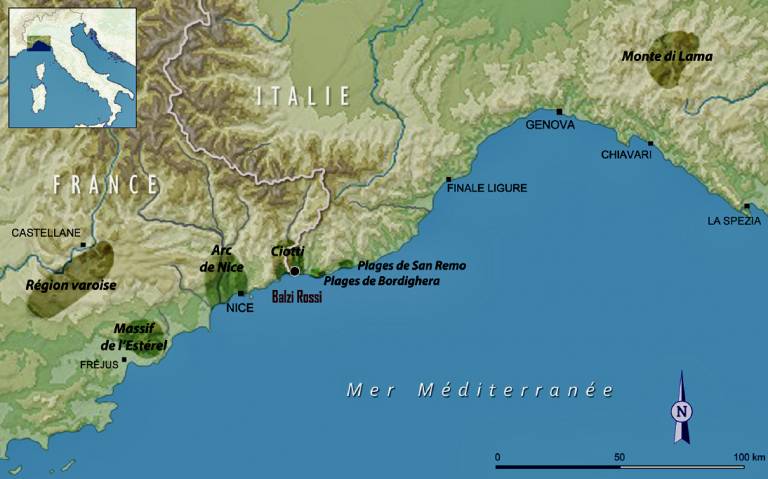Re-examining the Mousterian of Northern Italy and Southern France
27 March 2017
Balzi Rossi (Grimaldi) is a worldwide famous complex of Paleolithic sites located on the Franco-Italian border (Ventimiglia, Liguria).
 Especially known for its Upper Paleolithic occupations, each site also contained Middle Paleolithic deposits in which Mousterian evidence were early unearthed. The Museum of Prehistoric Anthropology of Monaco conserves a large part of these collections originated from Villeneuve's excavations at the end of the 19th century. This fieldwork based on forward-looking methods and commissioned by Prince Albert the 1st of Monaco involved several caves (Prince, Cavillon, and Enfants) and one shelter (Lorenzi). The few Barma Grande artefacts included were donated later on. Despite the challenges provided by this kind of assemblages, excavated over a century ago and at most composed of two thousands of pieces, it was very important to conduct an exhaustive study on these underestimated or unpublished Mousterian components. Indeed, different approaches evaluated their reliability and yielded new insights on Mousterian context and behaviors in the Balzi Rossi between MIS 5-3 embedded in new results and programs of researches.
Especially known for its Upper Paleolithic occupations, each site also contained Middle Paleolithic deposits in which Mousterian evidence were early unearthed. The Museum of Prehistoric Anthropology of Monaco conserves a large part of these collections originated from Villeneuve's excavations at the end of the 19th century. This fieldwork based on forward-looking methods and commissioned by Prince Albert the 1st of Monaco involved several caves (Prince, Cavillon, and Enfants) and one shelter (Lorenzi). The few Barma Grande artefacts included were donated later on. Despite the challenges provided by this kind of assemblages, excavated over a century ago and at most composed of two thousands of pieces, it was very important to conduct an exhaustive study on these underestimated or unpublished Mousterian components. Indeed, different approaches evaluated their reliability and yielded new insights on Mousterian context and behaviors in the Balzi Rossi between MIS 5-3 embedded in new results and programs of researches.
Historiographic researches updated and completed beforehand various settings. Geographical and stratigraphical distribution/reallocation, recoveries of artefacts, stocktaking of collections are few examples of better basis acquired by preparatory works. Regarding the specific study of the material, lithotype analysis revealed two main important results: large procurement territories, up to 150-180 km for some Mousterian groups (Cavillon-III and Inferior of Rivière Units, Lorenzi, Prince-E Unit), and an amazing constant techno-economic strategy (e.g. Levallois points in peripheral flints, Levallois blades in semi-local raw material, isolated allochtone retouched tools). However, techno-typology data allowed not only common patterns inter and intra sites but some variations underlined and confronted widely. These differences involved, for example, use of methods (global disappearance of Levallois methods, frequency of Discoïd debitage), functional and productions aims (abundant and voluminous cores in Lorenzi; huge, lengthened blades in Cavillon-Rivière's Inferior Unit; selection of blanks based on morphometry; scrapers and denticulate proportions). Compared on certain points to the other Balzi Rossi series stemming from modern excavations (Mochi, Bombrini, ex-Birreria, ex-Casino), a Mousterian synchronic and diachronic panorama had been drawn for the first time. Moreover, replaced within penecontemporaneous assemblages discovered in neighboring sites (e.g. Madonna dell'Arma, Caverna della Fate, Manie, San Francesco, Colombo, Santa Lucia Superiore), this outcome contributes to improve our knowledge on Mousterian material cultures and behaviors in Southeast of France, Italy as well as in the broader of Mediterranean area.
Mousterian in Balzi Rossi (Ventimiglia, Liguria, Italy): New insights and old collections
Elena Rossoni-Notter, Olivier Notter, Patrick Simon
DOI: 10.1016/j.quaint.2015.12.059
 Close
Close

